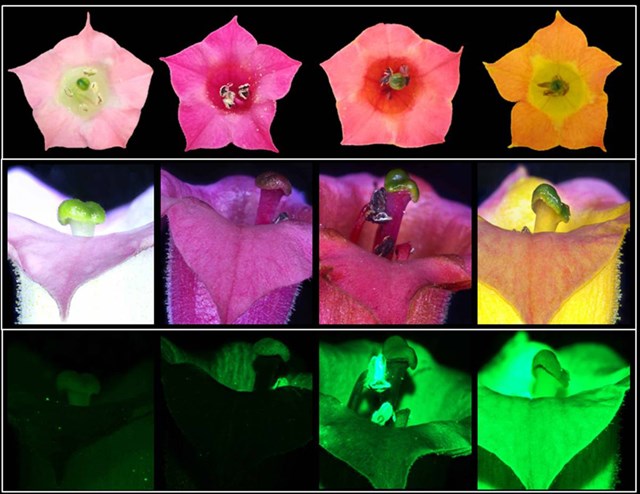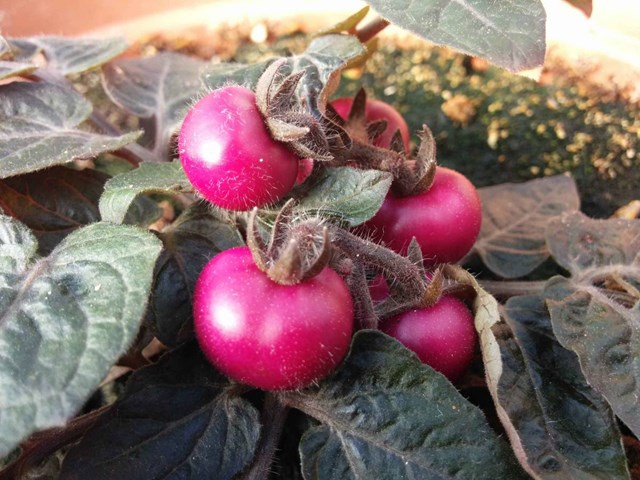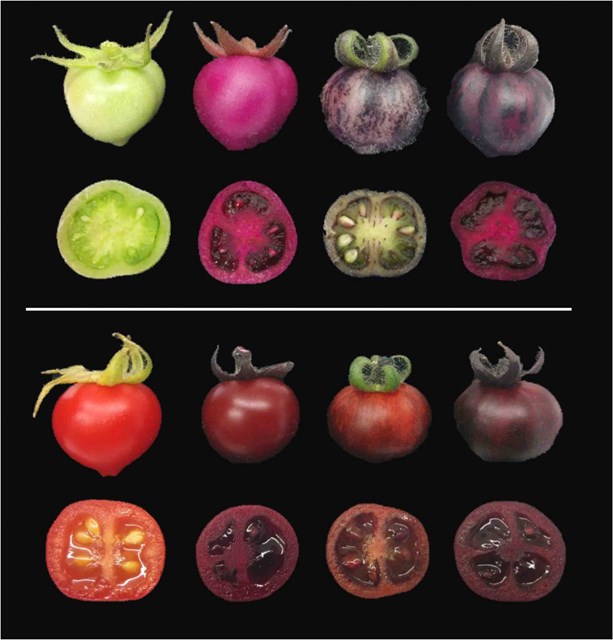Unripe (top) and ripe (bottom) tomatoes. Regular tomatoes (far left) start out green and turn red when ripe. In contrast, genetically engineered tomatoes assume different shades of red-violet, depending on whether they produce betalains (second from left), pigments called anthocyanins (second from right), or betalains together with anthocyanins (far right)
Pigments made by beets may help boost resistance to disease and the nutrition value of crops
Color in the plant kingdom is not merely a joy to the eye. Colored pigments attract pollinating insects, they protect plants against disease, they confer health benefits, and are used in the food and drug industries. A new study conducted at the Weizmann Institute of Science, published in the Proceedings of the National Academy of Sciences, USA, has now opened the way to numerous potential uses of betalains, the highly nutritious red-violet and yellow pigments known for their antioxidant properties and commonly used as food dyes.
Betalains are made by cactus fruit, flowers such as bougainvillea, and certain edible plants – most notably, beets. They are relatively rare in nature, compared to the two other major groups of plant pigments, and until recently, their synthesis in plants was poorly understood. Prof. Asaph Aharoni of Weizmann’s Department of Plant and Environmental Sciences and Dr. Guy Polturak, then a research student, along with other team members, used two betalain-producing plants – red beet (Beta vulgaris) and four o’clock flowers (Mirabilis jalapa) – in their analysis. Using next-generation RNA sequencing and other advanced technologies, the researchers identified a previously unknown gene involved in betalain synthesis and revealed which biochemical reactions plants use to convert the amino acid tyrosine into betalains.
To test their findings, the scientists genetically engineered yeast to produce betalains. They then tackled the ultimate challenge: reproducing betalain synthesis in edible plants that do not normally make these pigments.
The success announced itself in living color. The researchers produced potatoes, tomatoes, and eggplants with red-violet flesh and skin. They also managed to control the exact location of betalain production by, for example, causing the pigment to be made only in the fruit of the tomato plant but not in the leaves or stem.
Using the same approach, the scientists caused white petunias to produce pale violet flowers, and tobacco plants to flower in hues varying from yellow to orange-pink. They were able to achieve a desired hue by causing the relevant genes to be expressed in different combinations during the course of betalain synthesis. These findings may be used to create ornamental plants with colors that can be altered on demand.

Tobacco flowers in nature are pale pink (far left), but can take on new colors (three images on the right) when genetically engineered to produce betalains
But a change in color was not the only outcome. Healthy antioxidant activity was 60 percent higher in betalain-producing tomatoes than in average ones. “Our findings may in the future be used to fortify a wide variety of crops with betalains in order to increase their nutritional value,” says Prof. Aharoni.
An additional benefit is that the researchers discovered that betalains protect plants against gray mold, Botrytis cinerea, which causes annual losses of agricultural crops worth billions of dollars. The study showed that resistance to gray mold rose by a whopping 90 percent in plants engineered to make betalains.
The scientists had produced versions of betalain that do not exist in nature. “Some of these new pigments may potentially prove more stable than the naturally occurring betalains,” says Dr. Polturak. “This can be of major significance in the food industry, which makes extensive use of betalains as natural food dyes, for example, in strawberry yogurts.”

Tomatoes that have been genetically engineered to produce betalains only in the fruit, but not elsewhere in the plant
Furthermore, the findings of the study may be used by the drug industry. When plants start manufacturing betalains, the first step is conversion of tyrosine into an intermediate product, the chemical called L-dopa. Not only is this chemical itself used as a drug, it also serves as a starting material in the manufacture of additional drugs, particularly opiates such as morphine. Plants and microbes engineered to convert tyrosine into L-dopa may therefore serve as a source of this valuable material.
The research team included Noam Grossman, Dr. Yonghui Dong, Margarita Pliner, and Dr. Ilana Rogachev of Weizmann’s Department of Plant and Environmental Sciences and Dr. Maggie Levy, Dr. David Vela-Corcia, and Adi Nudel of the Hebrew University of Jerusalem.
Prof. Asaph Aharoni’s research is supported by the John and Vera Schwartz Center for Metabolomics, which he heads; the Leona M. and Harry B. Helmsley Charitable Trust; the Foundation Adelis; the Lerner Family Plant Science Research Fund; the Monroe and Marjorie Burk Fund for Alternative Energy Studies; the Sheri and David E. Stone Fund for Microbiota Research; Dana and Yossie Hollander, Israel; the A.M.N. Fund for the Promotion of Science, Culture and Arts in Israel; and the Tom and Sondra Rykoff Family Foundation.
Prof. Aharoni is the recipient of the André Deloro Prize and the incumbent of the Peter J. Cohn Professorial Chair.

